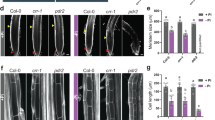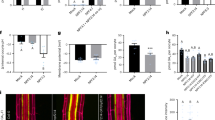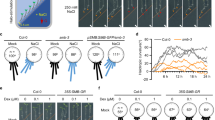Abstract
The coordinated distribution of inorganic phosphate (Pi) between roots and shoots is an important process that plants use to maintain Pi homeostasis. SHORT-ROOT (SHR) is well characterized for its function in root radial patterning. Here we demonstrate a role of SHR in controlling Pi allocation from root to shoot by regulating PHOSPHATE1 in the root differentiation zone. We recovered a weak mutant allele of SHR in Arabidopsis that accumulates much less Pi in the shoot and shows a constitutive Pi starvation response under Pi-sufficient conditions. In addition, Pi starvation suppresses SHR protein accumulation and releases its inhibition on the HD–ZIP III transcription factor PHB. PHB accumulates and directly binds the promoter of PHOSPHATE2 to upregulate its transcription, resulting in PHOSPHATE1 degradation in the xylem-pole pericycle cells. Our findings reveal a previously unrecognized mechanism of how plants regulate Pi translocation from roots to shoots.
This is a preview of subscription content, access via your institution
Access options
Access Nature and 54 other Nature Portfolio journals
Get Nature+, our best-value online-access subscription
$29.99 / 30 days
cancel any time
Subscribe to this journal
Receive 12 digital issues and online access to articles
$119.00 per year
only $9.92 per issue
Buy this article
- Purchase on Springer Link
- Instant access to full article PDF
Prices may be subject to local taxes which are calculated during checkout




Similar content being viewed by others
Data availability
The RNA-seq data in this study have been deposited in the NCBI Gene Expression Omnibus with the accession code GSE199834. Source data are provided with this paper.
References
Rouached, H. et al. Regulation of phosphate starvation responses in plants: signaling players and cross-talks. Mol. Plant 3, 288–299 (2010).
Hamburger, D. et al. Identification and characterization of the Arabidopsis PHO1 gene involved in phosphate loading to the xylem. Plant Cell 14, 889–902 (2002).
Liu, T.-Y. et al. PHO2-dependent degradation of PHO1 modulates phosphate homeostasis in Arabidopsis. Plant Cell 24, 2168–2183 (2012).
Chen, Y.-F. et al. The WRKY6 transcription factor modulates PHOSPHATE1 expression in response to low Pi stress in Arabidopsis. Plant Cell 21, 3554–3566 (2009).
Ye, Q. et al. The ubiquitin E3 ligase PRU1 regulates WRKY6 degradation to modulate phosphate homeostasis in response to low-Pi stress in Arabidopsis. Plant Cell 30, 1062–1076 (2018).
Silva-Navas, A. et al. Role of cis-zeatin in root responses to phosphate starvation. N. Phytol. 224, 242–257 (2019).
Hermans, C. et al. How do plants respond to nutrient shortage by biomass allocation? Trends Plant Sci. 11, 610–617 (2006).
Lei, M. et al. Genetic and genomic evidence that sucrose is a global regulator of plant responses to phosphate starvation in Arabidopsis. Plant Physiol. 156, 1116–1130 (2011).
Schneeberger, K. et al. SHOREmap: simultaneous mapping and mutation identification by deep sequencing. Nat. Methods 6, 550–551 (2009).
Benfey, P. N. et al. Root development in Arabidopsis: four mutants with dramatically altered root morphogenesis. Development 119, 57–70 (1993).
Hirano, Y. et al. Structure of the SHR–SCR heterodimer bound to the BIRD/IDD transcriptional factor JKD. Nat. Plants https://doi.org/10.1038/nplants.2017.10 (2017).
Ittisoponpisan, S. et al. Can predicted protein 3D-structures provide reliable insights into whether missense variants are disease-associated? J. Mol. Biol. 431, 2197–2212 (2019).
Rubio, V. et al. A conserved MYB transcription factor involved in phosphate starvation signaling both in vascular plants and in unicellular algae. Genes Dev. 15, 2122–2133 (2001).
Bustos, R. et al. A central regulatory system largely controls transcriptional activation and repression responses to phosphate starvation in Arabidopsis. PLoS Genet. 6, e1001102 (2010).
Cui, H. et al. An evolutionarily conserved mechanism delimiting SHR movement defines a single layer of endodermis in plants. Science 316, 421–425 (2007).
Arpat, A. B. et al. Functional expression of PHO1 to the Golgi and trans-Golgi network and its role in export of inorganic phosphate. Plant J. 71, 479–491 (2012).
Sebastian, J. et al. PHABULOSA controls the quiescent center-independent root meristem activities in Arabidopsis thaliana. PLoS Genet. 11, e1004973 (2015).
Carlsbecker, A. et al. Cell signalling by microRNA165/6 directs gene dose-dependent root cell fate. Nature 465, 316–321 (2010).
Miyashima, S. et al. Non-cell-autonomous microRNA165 acts in a dose-dependent manner to regulate multiple differentiation status in the Arabidopsis root. Development 138, 2303–2313 (2011).
Zheng, Z. et al. Blue light-triggered chemical reactions underlie phosphate deficiency-induced inhibition of root elongation of Arabidopsis seedlings grown in petri dishes. Mol. Plant 12, 1515–1523 (2019).
Chiou, T. J. & Lin, S. I. Signaling network in sensing phosphate availability in plants. Annu. Rev. Plant Biol. 62, 185–206 (2011).
Laurenzio, L. D. et al. The SCARECROW gene regulates an asymmetric cell division that is essential for generating the radial organization of the Arabidopsis root. Cell 86, 423–433 (1996).
Lei, M. et al. Ethylene signalling is involved in regulation of phosphate starvation-induced gene expression and production of acid phosphatases and anthocyanin in Arabidopsis. N. Phytol. 189, 1084–1095 (2011).
Schneeberger, K. et al. Simultaneous alignment of short reads against multiple genomes. Genome Biol. 10, R98 (2009).
Clough, S. J. & Bent, A. F. Floral dip: a simplified method for Agrobacterium-mediated transformation of Arabidopsis thaliana. Plant J. 16, 735–743 (1998).
Jain, A. et al. Differential effects of sucrose and auxin on localized phosphate deficiency-induced modulation of different traits of root system architecture in Arabidopsis. Plant Physiol. 144, 232–247 (2007).
Danku, J. et al. Large-scale plant ionomics. Methods Mol. Biol. 953, 255–276 (2013).
Lahner, B. et al. Genomic scale profiling of nutrient and trace elements in Arabidopsis thaliana. Nat. Biotechnol. 21, 1215–1221 (2003).
Bieza, K. & Lois, R. An Arabidopsis mutant tolerant to lethal ultraviolet-B levels shows constitutively elevated accumulation of flavonoids and other phenolics. Plant Physiol. 126, 1105–1115 (2001).
Bainbridge, K. et al. Grafting in Arabidopsis. Methods Mol. Biol. 1062, 155–163 (2014).
Dobin, A. et al. STAR: ultrafast universal RNA-seq aligner. Bioinformatics 29, 15–21 (2013).
Pertea, M. et al. StringTie enables improved reconstruction of a transcriptome from RNA-seq reads. Nat. Biotechnol. 33, 290–295 (2015).
Love, M. I. et al. Moderated estimation of fold change and dispersion for RNA-seq data with DESeq2. Genome Biol. 15, 550 (2014).
Yu, G. et al. clusterProfiler: an R package for comparing biological themes among gene clusters. Omics 16, 284–287 (2012).
Yoo, S.-D. et al. Arabidopsis mesophyll protoplasts: a versatile cell system for transient gene expression analysis. Nat. Protoc. 2, 1565–1572 (2007).
Saleh, A. et al. An efficient chromatin immunoprecipitation (ChIP) protocol for studying histone modifications in Arabidopsis plants. Nat. Protoc. 3, 1018–1025 (2008).
Xiao, X. et al. A group of SUVH methyl-DNA binding proteins regulate expression of the DNA demethylase ROS1 in Arabidopsis. J. Integr. Plant Biol. 61, 110–119 (2019).
Steffens, N. O. et al. AthaMap: an online resource for in silico transcription factor binding sites in the Arabidopsis thaliana genome. Nucleic Acids Res. 32, D368–D372 (2004).
Acknowledgements
This work was supported by grants from the Shanghai Sailing Program (no. 20YF1456100) to X.X. and from the Chinese Academy of Sciences to M.L.
Author information
Authors and Affiliations
Contributions
M.L. and X.X. conceived and designed the study. X.X. and J.Z. performed most of the experiments and analysed the data with M.L. The other authors assisted in the experiments and discussed the results. X.X., V.S. and M.L. wrote the manuscript.
Corresponding author
Ethics declarations
Competing interests
The authors declare no competing interests.
Peer review
Peer review information
Nature Plants thanks the anonymous reviewers for their contribution to the peer review of this work.
Additional information
Publisher’s note Springer Nature remains neutral with regard to jurisdictional claims in published maps and institutional affiliations.
Supplementary information
Supplementary Information
Supplementary Figs. 1–10, Table 1 and unprocessed gels for Supplementary Figs. 3, 8 and 9.
Supplementary Data 1
DEGs in the shoot of phod1.
Supplementary Data 2
Source data for Supplementary Figs. 1–10.
Supplementary Video 1
SHR–GFP in the root differentiation zone under P+ conditions.
Supplementary Video 2
SHR–GFP in the root differentiation zone under P− conditions.
Supplementary Video 3
PHB–GFP in the root differentiation zone under P+ conditions.
Supplementary Video 4
PHB–GFP in the root differentiation zone under P− conditions.
Source data
Source Data Fig. 1
Source data.
Source Data Fig. 2
Source data.
Source Data Fig. 3
Source data.
Source Data Fig. 4
Source data.
Source Data Fig. 2
Unprocessed western blot gels.
Source Data Fig. 3
Unprocessed western blot gels.
Source Data Fig. 4
Unprocessed western blot gels.
Rights and permissions
Springer Nature or its licensor holds exclusive rights to this article under a publishing agreement with the author(s) or other rightsholder(s); author self-archiving of the accepted manuscript version of this article is solely governed by the terms of such publishing agreement and applicable law.
About this article
Cite this article
Xiao, X., Zhang, J., Satheesh, V. et al. SHORT-ROOT stabilizes PHOSPHATE1 to regulate phosphate allocation in Arabidopsis. Nat. Plants 8, 1074–1081 (2022). https://doi.org/10.1038/s41477-022-01231-w
Received:
Accepted:
Published:
Issue Date:
DOI: https://doi.org/10.1038/s41477-022-01231-w
This article is cited by
-
Metabolic footprints in phosphate-starved plants
Physiology and Molecular Biology of Plants (2023)
-
All roads lead to PHO1
Nature Plants (2022)



